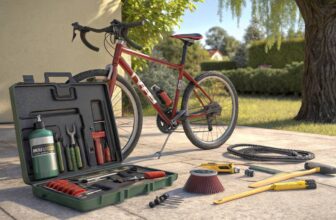Understanding Bike Speed
What’s in the Mix?
When it comes to hybrid bikes and their pace, several aspects can jazz up or jam your ride. Grasping these nuances can steer city travelers, weekend wanderers, and fitness newbies toward picking the perfect wheelie for their whims. Here’s what’s shaking the speed scene for hybrid bikes.
- Gear Ratios: Think of gears like the pace-setters of your ride. More gears, like those found in 21-speed cycles, let you dance across different terrains with ease, unlike their single-speed or 3-speed cousins. If you’re picking gears, think about where you’ll be cruising the most.
- Bike Weight: A bike’s heft or lack thereof is a biggie for speed and handling. Light bikes take off like rockets and scale inclines with grace. Let’s weigh in on some types:
Bike Type Weight Range (lbs) Road Bikes 17-20 Gravel Bikes 18-24 Mountain Bikes 25-30
Curious about more weights? Check out our road bike weight guide. - Tire Type and Pressure: Tires are the unsung heroes (or villains) of your speed. Hybrid bike tires bridge the gap between road racers and off-road champs. Keeping them plump and pumped minimizes the drag, upping your speed game. Swing by our tire talk for the scoop.
- Rider Position: Your riding pose isn’t just about comfort—it’s got everything to do with cutting through the wind. While hybrid bikes usually put you in a chill, upright stance for ease navigating urban jungles, some tweaks can make you sleeker. Need tips? Look up our position pointers.
- The Wind: The invisible fella that can either push you like a cheerleader or slow you down like a grumpy parent. Mastering gear shifts and riding tricks when the wind kicks up can be a game-changer.
- Road Conditions: From smooth highways to bumpy backroads, the surface under your wheels can make or break your speed. Riders hitting mixed paths should vary tires or fiddle with gears for top performance.
- Pedaling Technique: Pedaling like a pro means saving juice and going faster. Keeping a nice rhythm and knowing when to switch gears for the hill up ahead can up your ride. Peep our guide on gearing up for more insight.
- Component Upgrades: Swapping in some snazzy parts—light rims, fancy tires, even carbon frames—gives your speed a noticeable boost.
Upgrade Type Potential Speed Increase (%) Lightweight Wheels 3-5% Carbon Fiber Frame 4-7% - Rider Fitness: Ultimately, it’s not just about the bike, but also about the “engine”—that’s you! Keeping fit means faster legs on the go. Just setting out? Dive into our fitness fun page.
Each of these factors bakes into the overall speed pie of your hybrid bike. Fine-tuning these slices gives riders the power to cruise at their own pace, tailored to what feels right for them.
Gear Speed Options
Hybrid bikes come with different gear speed options, each suited for specific riding needs. Knowing these choices helps urban commuters, fitness newbies, and city folks get the most out of their hybrid bike speed.
3-Speed Bikes
A 3-speed bike is simple and perfect if you’re cruising on flat roads or taking on gentle hills. With a no-fuss setup that includes a low gear for easy pedaling, it’s a hit with weekend warriors and those looking for comfort. Not the best pick for big hills though.
| Feature | Description |
|---|---|
| Terrain | Flat paths, small hills |
| Gears | Low gear for easy riding |
| Riding Style | Low-key rides, short commutes |
| Ideal For | Urban commuters, Active seniors |
7-Speed Bikes
A 7-speed bike gives you more options, handling both flat stretches and some steeper climbs. It has low gears for climbing and high ones when you wanna speed up, making it great for riders who want a bit more variety in their journey.
| Feature | Description |
|---|---|
| Terrain | Flat land, milder slopes |
| Gears | Both low and high available |
| Riding Style | Flexible, mixed terrain rides |
| Ideal For | Multi-surface riders, Fitness beginners |
21-Speed Bikes
Need to tackle both flat roads and steep slopes? That’s where the 21-speed bike shines. Loaded with a wide range of gears, it’s ready for tough climbs and quick cruises, fitting for those craving a bike that takes on any terrain and heavy workouts.
| Feature | Description |
|---|---|
| Terrain | Flat, hilly regions |
| Gears | Broad spectrum (low to high) |
| Riding Style | Hard-core fitness, mixed terrains |
| Ideal For | Fitness enthusiasts, Car-to-bike converters |
Picking the right gear speed is crucial for squeezing the most out of your hybrid bike and reaching peak performance. For more on how your bike’s gears can boost your ride, check out our piece on hybrid bike gears.
Single-Speed vs. Multi-Speed
Picking between single-speed and multi-speed hybrid bikes can really change your bike rides around town or in the park. Knowing what sets them apart helps you choose the one that fits your riding style.
Single-Speed Bikes
Single-speeds, or fixies, have just one gear. Less moving parts mean they’re easy to handle and don’t need much looking after. Perfect for flat roads and city rides (Sixthreezero). With fewer parts to mess up or fix, they’re a lifesaver for city folks and weekend riders.
| Feature | Single-Speed Bikes |
|---|---|
| Gear Ratio | Single |
| Maintenance | Low |
| Terrain | Flat |
| Popular Uses | City cruising, track riding |
| Freewheel Mechanism | Nope |
You gotta keep pedaling on a fixie ’cause there’s no free ride. It’s quite the workout, making it a hit in cities and on tracks with lots of starts and stops. On the flip side, if you’re dealing with hills or uneven roads, this might not be your ride of choice.
Multi-Speed Bikes
Multi-speed bikes are like the Swiss Army knife of biking—built for whatever you throw at them. Whether you’ve got 3, 7, or even 21 gears, they change things up for hilly paths or tricky roads (Sixthreezero).
| Feature | Multi-Speed Bikes |
|---|---|
| Gear Ratios | Lots (3, 7, 21…) |
| Maintenance | Moderate |
| Terrain | Mixed |
| Popular Uses | New exercisers, urban adventurers, older riders |
| Freewheel Mechanism | Yep |
Multi-speeds let you tweak your ride depending on the ups and downs. Lower gears help on hills, while higher gears let you zoom on flat or downhill paths. This makes them ideal for beginner riders, city explorers, and energetic older folks.
When choosing between a single-speed or a multi-speed hybrid bike, think about where you typically find yourself pedaling. Check out more on choosing gear ratios with our guides on hybrid bike gears and other gearing options.
Weight Considerations
Weight plays a big role when it comes to how hybrid bikes perform and how speedy they can be. Knowing the weight ballpark for different types of bikes can help city commuters, weekend warriors, and fitness buffs pick the right ride.
Road Bike Weight Range
Road bikes are all about speed. Made with lightweight stuff, they’re a go-to for those aiming to zoom around town or the countryside.
| Bike Type | High-End Model Weight (lbs) | Mid-Range Model Weight (lbs) |
|---|---|---|
| Road Bike | 15-17 | 18-20 |
The big wigs at the Union Cycliste Internationale (UCI) say racing bikes have to be at least 6.8 kilograms (around 15 pounds). Lightweight materials like carbon fiber make these bikes fly on the road. Got a need for speed? Check out how hybrid compares to road bikes.
Gravel Bike Weight Range
Gravel bikes are your trusty sidekick for both paved paths and dirt tracks. They’re a bit on the heavier side because they’re built to last and tackle any terrain.
| Bike Type | High-End Model Weight (lbs) | Budget Model Weight (lbs) |
|---|---|---|
| Gravel Bike | 18-20 | 22-26 |
Top-notch gravel bikes clock in around 18-20 pounds (8.1-9 kg), while the more budget-friendly options can weigh 22-26 pounds (10-11.8 kg). They balance toughness with comfort, making them a solid pick for those who like mixing up their routes with multi-surface riding.
Mountain Bike Weight Range
Built for tough trails and rowdy conditions, mountain bikes are the bulldozers of the biking world. They pack some weight because of their solid frame and extra gadgets like suspensions.
| Bike Type | General Weight Range (lbs) |
|---|---|
| Cross-Country Mountain Bike | 22-24 |
| Trail/Enduro Mountain Bike | 30+ |
Cross-country models tip the scales at 22-24 pounds (10-11 kg), but those hardcore trail and enduro bikes start at over 30 pounds (13.6 kg). The added heft comes from cool stuff like suspension forks and shocks (The Pro’s Closet). Curious about how much bike weight really matters? Check out this article.
Choosing the right bike isn’t just about looks—it’s about weight, how you plan to use it, and what feels right under you. Whether you crave a feather-light road rocket or a solid rock-crawling machine, keeping these weight classes in mind will steer you right. Ready to tweak and pimp your ride? Pop over to our spot on hybrid bike upgrades.
Upgrading Bike Components
Giving your hybrid bike a boost can really up its street cred! If you’re thinking of tricking out your ride for better speed and handling, two solid ideas are lightweight wheels and the magic of carbon fiber. These nifty tweaks can make your bike nimbler and your rides a whole lot more fun.
Lightweight Wheels and Tires
Swapping to lightweight wheels and tires can totally change the game. Simply put, less spinning weight means better speed and smoother rides (The Pro’s Closet).
Choosing lighter options helps you pick up speed faster and dance through traffic. For city bikers who stop and go a lot—of folks new to biking who want a bit more zip—this is the way to roll.
| Component | Weight Savings | Impact on the Ride |
|---|---|---|
| Lightweight Wheels | Up to 500g | Quick acceleration, better handling |
| Lightweight Tires | Up to 200g | Smoother ride, easy rolling |
Benefits of Carbon Fiber
Carbon fiber? It’s like the superhero of bike materials—super light yet super strong. Sticking it in wheels, frames, and such, can make your ride slicker and quicker (The Pro’s Closet).
If you’re on the fitter and lighter side, a bike trimmed with carbon fiber feels like riding the wind, especially when climbing hills. That power-to-weight balance means serious speed! But for the average Joe (or Jane), shaving some pounds off yourself might be as game-changing as trimming your bike.
| Component | Benefit | Example Impact |
|---|---|---|
| Carbon Fiber Frame | Big weight drop | Better power-to-weight ratio |
| Carbon Fiber Wheels | Better aerodynamics | Zoom faster, use less gas! |
To really kick your hybrid bike’s performance up a notch, these upgrades are golden. Check out more on hybrid bike upgrades, hybrid bike components, and hybrid bike weight.
Importance of Bike Weight
When hopping on a bicycle, how much it weighs can really make or break the ride. Especially for hybrid bikes, which cater to a melting pot of folks — whether you’re zipping around the city or gearing up for retirement rides. Let’s chew the fat on how weight impacts the ride and this fancy term called power-to-weight ratio.
Impact on Performance
The weight of a bike isn’t just a number; it’s a game-changer for speed demons and hill conquerors alike. The lighter it is, the less effort it takes to get it rolling, and climbing feels like less of a slog. Top-shelf road bikes usually kick it in the 15-17 pound zone, while your everyday models might beef up to 18-20 pounds. And just so you know, those pro-level racers have to keep their bikes above 6.8 kilograms — that’s a rule, not just a suggestion.
| Bike Type | Weight Range (lbs) | Weight Range (kg) |
|---|---|---|
| Fancy Road Bike | 15-17 | 6.8-7.7 |
| Everyday Road Bike | 18-20 | 8.1-10 |
| Fancy Gravel Bike | 18-20 | 8.1-9 |
| Budget Gravel Bike | 22-26 | 10-11.8 |
Now, let’s talk about where you can really ditch some weight: wheels and tires. They matter a ton because they’re spinning. Lighten them up with some carbon fiber — and suddenly, you’re not just lighter, but sleek and aerodynamic too.
Curious about those hybrid bike scales? Check ours out here.
Power-to-Weight Ratio
Power-to-weight ratio ain’t just a mouthful; it tells you how much bang you’re getting for your pedal-powered buck, especially when hills turn into obstacles. It’s how much muscle you’re throwing down compared to your body and bike’s heft. Those feather-light folks? They usually get a boost here, as long as they’re fit and raring to go.
For most casual riders, shaving off more grease from your diet might help more than trimming bike grams. Matching bike heft with fitness goals is where the magic happens.
Want to nerd out on hybrids more? Check out our reads on hybrid bike geometry and hybrid bike frames.
Gearing Explained
Getting a handle on gear ratios is the secret sauce to a kick-ass ride on hybrid and gravel bikes. Knowing these bad boys inside out can help you zip past traffic on your hybrid rig or conquer those gnarly gravel trails.
Hybrid Bike Gear Ratios
Hybrid bikes are the Swiss Army knives of the cycling world. They’re perfect for buzzing through city streets, enjoying a chilled weekend ride, or starting a fitness journey. These versatile beasts usually have a mash-up of road and mountain bike parts. One big deal here is the gear ratio—it plays a huge part in keeping your ride smooth whether you’re cruising the park or tackling urban terrain.
Most hybrids roll with a chainring up front around 32 teeth, tagged with a friendly road cassette at the back. Usually, you’ve got something like 11-32 or 11-36 teeth clinging to the rear axle (Ribblecycles).
| Chainring | Rear Cassette |
|---|---|
| 32t | 11-32 |
| 32t | 11-36 |
These setups keep things balanced—speedy when you need it, but equally prepped for a few killer hills. Ideal for urbanites and those who like swapping asphalt for dirt now and then. Dive into our hybrid bike gears guide for the full scoop.
Gravel Bike Gear Ratios
Gravel bikes aren’t just tougher-looking cousins—they’re built for the wild stuff, meaning their gears need to do more heavy lifting than hybrids. They get the job done with bigger chainrings, about 40 to 44 teeth, plus mountain bike cassettes that come in around 11-42 or 10-44 teeth maybe (Ribblecycles).
| Chainring | Rear Cassette |
|---|---|
| 40-44t | 11-42 |
| 40-44t | 10-44 |
This means gravel bikes pack a ton of gears, perfect for making mincemeat of steep hills and rough roads. If hitting trails or touring is your thing, our articles on hybrid bike trails and hybrid bike touring are totally worth the read.
Picking the right gear setup comes down to where—and how—you plan to ride. Don’t miss out on our guides about keeping your hybrid in top shape and our picks for the best hybrid bikes for seniors to ensure every ride is a joyride.
Optimal Gearing Setup
Picking the right gears for your hybrid bike can make a world of difference, particularly if you’re city bound or just like a good weekend ride. Let’s jump into the best setups for zipping through the streets and semi-compact tweaking.
Road Riding Gearing
When pedaling through the city or working up a sweat, the right gears save your legs from doing overtime. An 11-32 or 11-36 cassette works wonders, especially when your journey involves hills (Ribblecycles). These options spread the workload evenly, so you don’t feel like you’re dragging a bus uphill.
| Gear Setup | Best Situation |
|---|---|
| 11-32 Cassette | City streets, gentle hills |
| 11-36 Cassette | Tougher climbs, mixed routes |
This setup makes switching between flats and climbs feel like a breeze, letting you master any pathway you encounter. Thinking about pimping your ride? Check extras for your hybrid ride to match your gearing.
Semi-Compact Gearing Setup
For those who enjoy a bit of racing on weekends or fancy themselves as the next Lance, a semi-compact setup’s a winner. Pair up a 36/52 chainring with an 11/25 to 11/36 cassette, and you’ve got speed and hill-climbing down to an art (Ribblecycles). It’s the mix that gives both speed demons and novice climbers the upper hand.
| Gear Setup | Best Situation |
|---|---|
| 36/52 Chainring | Everyday rides, friendly races |
| 11/25 Cassette | Smooth roads, quick dashes |
| 11/36 Cassette | Mixed tracks, uphill battles |
This setup helps you keep a steady pace while switching gears effortlessly, handling different rides like a champ. Curious about bike tweaks or comparisons? Peek at our reads on gearing your hybrid and hybrids taking on road bikes.
By picking the right gears, your bike becomes your perfect ride companion, making each trip comfy and speedy. Whether you’re eyeing road gears or leaning into a semi-compact deal, knowing the details puts you in the driver’s seat of your cycling journey.




